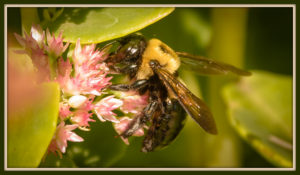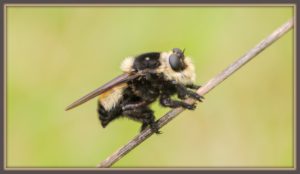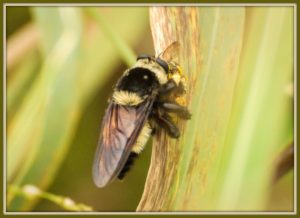Monday Mimicry Pt. 4
Monday Mimicry Pt.4
April 3, 2017
Double-click on any image to view it full size. Click the back-button to return to your place on this page.
Greetings!
In one sense, this week’s essay picks up from last week, because one of last week’s pictures included a Bumble Bee, and that’s where this week’s set starts. Pictures 1 thru 3 all feature Bumble Bees. In #1 you can see particularly well the long maxilla (tongue sheath), which the bee introduces into flowers and from which the tongue proper then projects to obtain nectar.

There are many different species of Bumble Bees, and the length of the maxilla is one way to help determine species. The most common east coast species is Bombus impatients, and I have no recent to think that these guys are not members of that species. Bumble Bees are very important plant pollinators, and #2 shows pollen on the bee’s legs and abdomen.

Bees have four wings, but the smaller hind wings are normally attached along their front edge to the rear edge of the larger fore wings by what is almost a natural velcro fastening system. If you look carefully at #3 it is reasonably easy to see the two right-hand wings slightly overlapping.

At a quick glance, #4 looks rather like a Bumble Bee. In fact, it is a Southern Bee Killer, Mallophora orcina, a member of one of the many genuses of Robber Flies.

It is an active predator, consuming various insects, including bees. It presumably benefits from looking like a Bumble Bee in that other insects may be lulled into a false sense of security, and venture too close to it, at which point it will pounce. #5 was taken just about two minutes after #4, and the hunter has caught some kind of bee – you can see parts of its body under its captor, and a wing projecting in front of the Killer’s head.

#6 is a much clearer image of the same species, but without a meal.

This kind of mimicry is known as aggressive mimicry. Although it far pre-dates human existence, it might be compared to the human nautical practice, dating back at least several hundred years, of making your vessel look like a peaceful trading ship until you get within striking distance of your enemy, at which point you drop the pretence, uncover your guns, and open fire. Such tactics were used by both sides in both World Wars, when such vessels were often referred to as “Q-Ships”.
Have a great week!